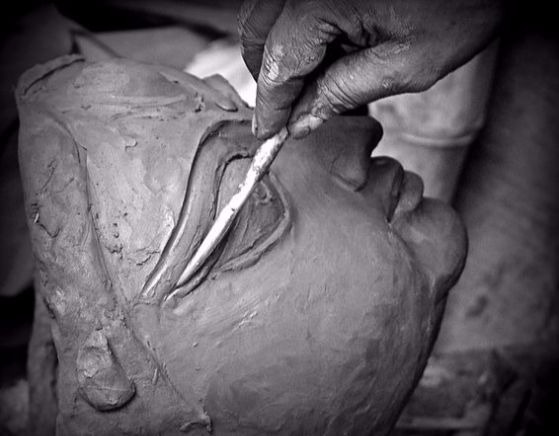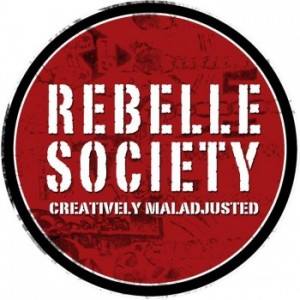Where Does the Goddess Come From?

{source}
Have you ever wondered where the Goddess comes from and why she has been hidden from us, from the public eye, so to speak?
Some, especially those whom the present setup serves well or at least does not affect, would like to argue that this is a historical coincidence, and that perhaps the Goddess is not that important or even present in our psyche. But I think these times testify to exactly the opposite — there is an absolute need for the resurrection of the Goddess in her full glory.
So where does the Goddess come from? Joseph Campbell, in Goddess: Mysteries of the Feminine Divine, and Elaine Pagels, in her many books on early Christianity, tell us the external history of the birth and loss of the Goddess.
Goddess: the Mother of Physical Birth
Historically, so archaeologists and anthropologists tell us, the Goddess appears in early agricultural societies from about 7,000 BCE (and some as early as 10,000 BCE). We can clearly see her through the eyes of people who worshiped her as a full-bodied, voluptuous goddess certain of the power of her body.
Indeed, it is her body that gives her power to give life, to create life. Without her, there is no life. She is both sexual and fertile, a life-giver and sustainer.
I like to imagine her as Sophia Loren in her early Italian films: fully feminine and yet fully powerful because of her femininity.
Goddess: The Mother of Spiritual Birth (Second Birth)
The powerful image of this full-bodied goddess often overshadows the fact that she is not only the protector of the harvest (material goods) and the Mother Goddess of us all who gives us our biological existence, she also carries secret knowledge (magic) for us.
She is present in spiritual terms as the mother of our second birth — our birth as Campbell describes ‘as spiritual entities’. And thus she awakens in us the need for spiritual purpose in our lives.
The Expelled Goddess
When the hunter-gatherer tribes arrived in Europe with their masculine gods — tall hunks with bows and arrows — they simply married local goddesses, as it seemed to be the natural thing to do. That is why, Campbell says, Zeus ended up with so many wives. He wasn’t being naughty, there were just too many lovely local goddesses he could marry! (This is his version of the story, anyway, and he sticks to it).
But it was not always a story with a happy ending. Eventually, some hunting tribes came with their ideas of one god who could not accept the presence of a goddess. She was conquered, lost her status, and came to be called an Abomination. Notice the capital A, as even they must have known of her powers.
In the fourth century CE, St. Augustine in his City of God describes witnessing goddess celebrations in Carthage where he lived (and yes, he called it an Abomination as well). The procession moving through the city in honor of the sensual and voluptuous goddess upset the male ascetic gods of the day (and their saints).
From then on, only male priests were in charge of worship, and the obsession with hard masculinity went so far that only animals with perfect male organs could be slaughtered at the altars of that super-masculine god. The life-giving Creatrix was replaced by a judgmental father figure.
Goddess in Hiding
No wonder some early Christians (later labelled as heretics or Gnostics) in the early CE centuries considered this super-masculine god a rather malevolent usurper and introduced his mother to him; she told him in no uncertain terms what she thought of his usurpation!
When he posed as the only god and creator, the Goddess would come out and tell him, “Do not lie!” and remind him that she created him only to administer to creation.
Indeed, some Gnostic sources, considered this the First Thought (“I am Protennoia, the Thought that dwells in the Light… she who exists before the All… I am the Invisible One within the All,” as she claims in one of the Gnostic sources, Trimorphic Protennoia.
The Gnostics also referred to Abraxas, the Gnostic god, who was the first manifestation from the undifferentiated cosmic soup called the Pleroma, and was both female and male (all that came out form Pleroma was in pairs of opposites).
In fact, in many sources, the God/dess is androgynous, containing both female and male within (“I am Mother (and) I am Father, since I copulate with myself… I am the Womb that gives shape to the All by giving birth to the Light that shines in splendor… I am the fulfillment of the All, that is, Meirothea, the glory of the Mother.”)
And my favorite self-declaration of the Goddess in a Gnostic poem called “The Thunder, Perfect Mind”: “For I am the first and the last. I am the honored one and the scorned one. I am the whore and the holy one. I am the wife and the virgin… For I am knowledge and ignorance… I am shameless; I am ashamed. I am strength and I am fear.”
Similarly, in some native tribes, Campbell tells us, on special occasions women are invited to sacred male rituals as an acknowledgement that they (women) have always known them and, in fact, are the originators of sacred magic.
The creation myths say that in the Age of Ancestors, we were all one, there were no divisions between masculine and feminine, animals and trees. Then something happened, some atrocity, some wrong turn was taken, and the world differentiated.
So what is the point of it all?
The point is: let’s not argue over who or what was first, as all we have our stories, sacred and mythological. It is important to remember, however, that all stories have a common thread of underlying unity which was broken. The balance between the feminine and masculine was disturbed, and we have become separate from each other.
It is important to also remember that the stories are never told without intent. There is always an underlying reason and there is always an interpretation which often suits the powers that be which are supported by institutions they create to legitimize themselves. Just as there are institutions that promote one vision of the Universe over another. And thus we have the imbalance.
Miraculously, the goddess has survived the onslaughts of history and one-sided interpretations
In India, in 800 BCE, Kena Upanishad came to being, and this is where the female Goddess Uma introduces the knowledge of Brahman to the male gods, who had no knowledge of the highest truth until then.
Around 900 CE, the Tantra was born, and with it, the worship of the Goddess in her most intimate way, often through sexual practices that enacted the birth of the Universe and, through them, restored the temporary balance between the masculine and feminine in our Consciousness. What was an Abomination to ascetics became a way to higher consciousness.
Later, the Catholic Church began a slow introduction of Mary, the Mother of God, and in the alternative Gnostic traditions, the much neglected and misinterpreted Mary Magdalene was often seen as the representation of Sophia (the Divine wisdom).
And today, faced with environmental and other threats, we turn again to the Goddess Gaia for salvation.
So perhaps the question should not be Where does the goddess come from? but rather, How can she be integrated back into our lives now?
***
Dr. Joanna Kujawa is the author of Jerusalem Diary (a spiritual travelogue) and many short stories, essays and academic pieces. She sees herself as a Spiritual Detective who asks difficult questions about spirituality, such as ‘Can spirituality and sexuality be experienced as one?’, ‘Who was the real Mary Magdalene?’, ‘How can we include eco-spirituality in our belief systems?’ and ‘How can we bring back the Divine Feminine to create a more balanced and interconnected world?’ Her goal is to create and participate in the shift in consciousness about spirituality, our connection to nature, and our place in the Universe. She has PhD from Monash University, and MA and BA from the University of Toronto. She is immoderately passionate about her Goddess News blog. You could connect with her via her website, Facebook, Twitter or YouTube.
***
{Join us on Facebook, Twitter, Instagram & Pinterest}

